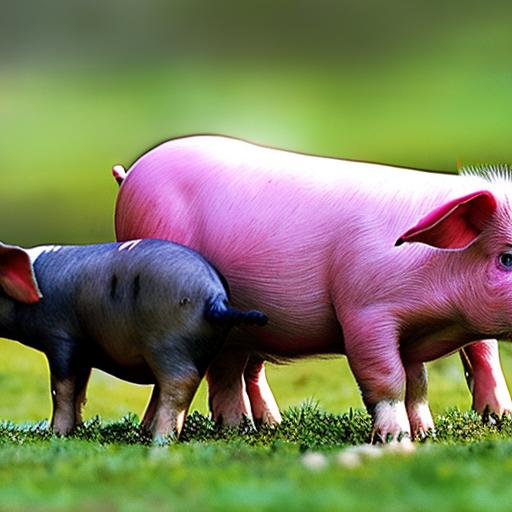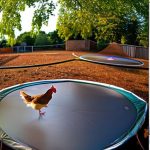Keeping chickens and pigs together is a farming practice that has gained popularity in recent years. This practice involves raising chickens and pigs in the same area, allowing them to interact and benefit from each other’s presence. While traditionally, chickens and pigs were kept separately, many farmers are now realizing the advantages of integrating these two animals.
The main reason why keeping chickens and pigs together is becoming popular is because of the mutual benefits it provides. Chickens and pigs have different behaviors and dietary needs, which complement each other well. Additionally, this practice is cost-effective and sustainable, as it reduces the need for chemical fertilizers and pesticides.
Key Takeaways
- Keeping chickens and pigs together can be a mutually beneficial arrangement for small-scale farmers.
- Chickens can help control pests and provide manure for pigs, while pigs can help till the soil and provide a source of protein for chickens.
- Understanding the natural behaviors of chickens and pigs is important for creating a harmonious living environment.
- Adequate housing and fencing is necessary to ensure the safety and well-being of both animals.
- A balanced diet and proper hygiene practices are essential for maintaining the health of chickens and pigs in a mixed system.
Benefits of keeping chickens and pigs together
One of the main benefits of keeping chickens and pigs together is the mutual benefits for both animals. Chickens help to control pests such as flies, ticks, and other insects that can bother pigs. They also eat leftover food scraps from the pigs, reducing waste and providing additional nutrition for the chickens. On the other hand, pigs help to till the soil, which can be beneficial for the chickens as they can find worms and insects to eat.
Another advantage of this mixed farming practice is that it is cost-effective and sustainable. By integrating chickens and pigs, farmers can reduce their reliance on chemical fertilizers and pesticides. The chickens provide natural fertilizer through their droppings, which enriches the soil and promotes healthy plant growth. This reduces the need for synthetic fertilizers, saving farmers money and reducing their environmental impact.
Understanding the behavior of chickens and pigs
Chickens and pigs have different behaviors, so it is important to understand their characteristics before introducing them to each other. Chickens are social animals that live in flocks and have a pecking order. They are generally docile but can become aggressive if they feel threatened or if there is competition for resources such as food or nesting space.
Pigs, on the other hand, are intelligent and curious animals. They are social animals that live in groups called sounders. Pigs can be territorial and may exhibit aggressive behavior if they feel their space is being invaded or if they are competing for resources. It is important to provide enough space and resources for both chickens and pigs to minimize aggression.
When introducing chickens and pigs to each other, it is best to do so gradually. Start by allowing them to see and smell each other through a fence or barrier. This will help them become familiar with each other’s presence without direct contact. Once they are comfortable, you can gradually allow them to interact under supervision.
Housing requirements for chickens and pigs
When keeping chickens and pigs together, it is important to provide suitable housing for both animals. For chickens, a chicken coop or henhouse is necessary to provide shelter from the elements and predators. The coop should have nesting boxes for the hens to lay their eggs and perches for roosting at night. It should also have adequate ventilation and lighting.
For pigs, a pigsty or pigpen is required to provide shelter and a comfortable resting area. The pigsty should be well-ventilated and have enough space for the pigs to move around freely. It should also have a separate area for feeding and watering.
In terms of space requirements, chickens need about 4 square feet per bird in the coop, while pigs need about 50 square feet per pig in the pigsty. It is important to provide enough space for both animals to prevent overcrowding, which can lead to stress and aggression.
Proper ventilation is essential in both the chicken coop and pigsty. Good air circulation helps to prevent the buildup of ammonia from animal waste, which can be harmful to the respiratory health of both chickens and pigs. Adequate lighting is also important, as it helps regulate the animals’ natural behaviors and promotes egg production in chickens.
Feeding requirements for chickens and pigs
Chickens and pigs have different nutritional needs, so it is important to provide a balanced diet for both animals. Chickens are omnivores and require a diet that includes grains, protein, vitamins, and minerals. They can be fed a combination of commercial chicken feed, kitchen scraps, and forage such as grass and insects.
Pigs, on the other hand, are omnivores and require a diet that includes grains, protein, vitamins, and minerals. They can be fed a combination of commercial pig feed, kitchen scraps, and forage such as grass and roots. Pigs also require a source of fresh water at all times.
When feeding chickens and pigs together, it is important to ensure that both animals have access to their respective feeds. This can be done by providing separate feeding areas or by using feeders that are designed to accommodate both chickens and pigs. It is also important to monitor the animals’ feeding behavior to ensure that they are getting enough food and to prevent aggression or competition for resources.
Health considerations for chickens and pigs

Keeping chickens and pigs together requires careful attention to their health needs. Both animals are susceptible to certain diseases and parasites, so it is important to take preventive measures to keep them healthy.
Common health issues for chickens include respiratory infections, parasites such as mites and lice, and egg-related problems such as egg binding or prolapse. Regular check-ups by a veterinarian are important to monitor the health of the flock and to detect any potential issues early on. Vaccinations may also be necessary to protect against common diseases such as Newcastle disease or avian influenza.
Pigs are susceptible to diseases such as swine flu, foot-and-mouth disease, and parasites such as worms or ticks. Regular check-ups by a veterinarian are important to monitor the health of the herd and to detect any potential issues early on. Vaccinations may also be necessary to protect against common diseases.
In addition to regular check-ups and vaccinations, it is important to maintain good hygiene practices in a mixed poultry and pig system. This includes keeping the housing clean and dry, providing clean water and feed, and regularly removing manure and other waste products. Good hygiene practices help to prevent the spread of diseases and parasites between animals.
Managing waste and hygiene in a mixed poultry and pig system
Managing waste and maintaining good hygiene practices are essential in a mixed poultry and pig system. Both chickens and pigs produce manure, which can be a valuable source of fertilizer when managed properly.
To manage manure in a mixed system, it is important to separate the chicken droppings from the pig manure. Chicken droppings can be collected and composted to produce nutrient-rich fertilizer for the garden or field. Pig manure can be collected and stored in a separate area for later use as fertilizer or it can be used immediately on the land.
It is important to maintain good hygiene practices in the housing areas to prevent the spread of diseases. This includes regularly cleaning and disinfecting the chicken coop and pigsty, providing clean water and feed, and regularly removing manure and other waste products. It is also important to practice good biosecurity measures, such as limiting access to the farm by unauthorized personnel or vehicles, to prevent the introduction of diseases.
Potential risks and challenges of keeping chickens and pigs together
While there are many benefits to keeping chickens and pigs together, there are also potential risks and challenges that need to be considered. One of the main risks is the transmission of diseases between animals. Chickens and pigs can carry different pathogens that can be harmful to each other. It is important to monitor the health of both animals regularly and take preventive measures such as vaccinations to reduce the risk of disease transmission.
Another challenge of managing a mixed system is the potential for aggression between chickens and pigs. Chickens can be territorial and may peck at or chase pigs, while pigs can be aggressive if they feel threatened or if there is competition for resources. Providing enough space and resources for both animals can help minimize aggression, but it is important to monitor their behavior and intervene if necessary.
To mitigate potential risks and challenges, it is important to have a management plan in place. This includes regular check-ups by a veterinarian, proper vaccination protocols, and good hygiene practices. It is also important to provide enough space and resources for both animals to minimize aggression and competition.
Legal considerations for keeping chickens and pigs together
Before starting a mixed poultry and pig system, it is important to consider the legal requirements and regulations that apply to keeping chickens and pigs. Depending on the location, there may be specific regulations and permits required for keeping these animals.
Some areas have zoning laws that restrict the types of animals that can be kept in certain areas. It is important to check with local authorities or agricultural extension offices to determine if there are any restrictions or permits required for keeping chickens and pigs together.
In addition to zoning laws, there may also be regulations regarding the handling and disposal of manure and other waste products. It is important to comply with these regulations to prevent environmental contamination and to maintain good neighbor relations.
Is keeping chickens and pigs together right for you?
Keeping chickens and pigs together can be a rewarding and sustainable farming practice. It provides mutual benefits for both animals, reduces the need for chemical fertilizers and pesticides, and can be cost-effective. However, it also requires careful planning, management, and attention to the health needs of both animals.
Before starting a mixed poultry and pig system, it is important to consider the benefits and challenges of this practice. Factors such as space availability, legal requirements, and personal preferences should be taken into account. It is also important to have a management plan in place, including regular check-ups by a veterinarian, proper vaccination protocols, and good hygiene practices.
Overall, keeping chickens and pigs together can be a successful and rewarding farming practice when done properly. It provides an opportunity to integrate different animals and utilize their natural behaviors and characteristics to create a sustainable and efficient farming system.
If you’re considering keeping chickens and pigs together, it’s important to understand the dynamics and requirements of both animals. In a recent article by Poultry Wizard, they explore the topic of cohabitating chickens and pigs and provide valuable insights on how to successfully manage this combination. From discussing the benefits of having these two species together to addressing potential challenges and offering practical tips, this article serves as a comprehensive guide for anyone interested in this unique farming approach. To learn more about keeping chickens and pigs together, check out the article here.
FAQs
What are the benefits of keeping chickens and pigs together?
Keeping chickens and pigs together can have several benefits. Chickens can help to keep the pig’s living area clean by eating insects and parasites, while pigs can help to till and fertilize the soil for the chickens to forage.
Is it safe to keep chickens and pigs together?
Yes, it is generally safe to keep chickens and pigs together as long as they are properly managed and their living areas are kept clean. However, it is important to note that pigs can be aggressive towards chickens, especially if they are not used to being around them.
What should be considered when keeping chickens and pigs together?
When keeping chickens and pigs together, it is important to ensure that they have separate living areas to prevent any potential conflicts. Additionally, their living areas should be kept clean and free of any potential hazards, such as sharp objects or toxic substances.
What should be the size of the living area for chickens and pigs?
The size of the living area for chickens and pigs will depend on the number of animals being kept and their size. As a general rule, chickens require at least 2-3 square feet of space per bird, while pigs require at least 50 square feet of space per animal.
What should be the diet of chickens and pigs when kept together?
Chickens and pigs have different dietary requirements, so it is important to ensure that they are fed separately. Chickens require a diet that is high in protein and calcium, while pigs require a diet that is high in carbohydrates and fiber. It is important to consult with a veterinarian or animal nutritionist to ensure that both animals are receiving the proper nutrition.
Meet Walter, the feathered-friend fanatic of Florida! Nestled in the sunshine state, Walter struts through life with his feathered companions, clucking his way to happiness. With a coop that’s fancier than a five-star hotel, he’s the Don Juan of the chicken world. When he’s not teaching his hens to do the cha-cha, you’ll find him in a heated debate with his prized rooster, Sir Clucks-a-Lot. Walter’s poultry passion is no yolk; he’s the sunny-side-up guy you never knew you needed in your flock of friends!







